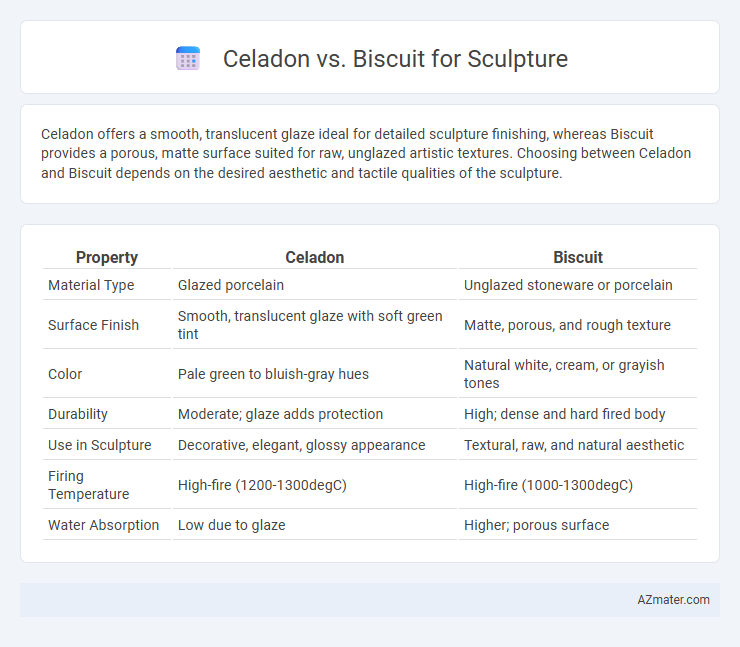Celadon offers a smooth, translucent glaze ideal for detailed sculpture finishing, whereas Biscuit provides a porous, matte surface suited for raw, unglazed artistic textures. Choosing between Celadon and Biscuit depends on the desired aesthetic and tactile qualities of the sculpture.
Table of Comparison
| Property | Celadon | Biscuit |
|---|---|---|
| Material Type | Glazed porcelain | Unglazed stoneware or porcelain |
| Surface Finish | Smooth, translucent glaze with soft green tint | Matte, porous, and rough texture |
| Color | Pale green to bluish-gray hues | Natural white, cream, or grayish tones |
| Durability | Moderate; glaze adds protection | High; dense and hard fired body |
| Use in Sculpture | Decorative, elegant, glossy appearance | Textural, raw, and natural aesthetic |
| Firing Temperature | High-fire (1200-1300degC) | High-fire (1000-1300degC) |
| Water Absorption | Low due to glaze | Higher; porous surface |
Introduction to Celadon and Biscuit in Sculpture
Celadon is a translucent glaze with a pale green or blue-green hue, traditionally used in East Asian ceramics, valued for its smooth, glass-like finish that enhances the fine details of sculptures. Biscuit, also known as unglazed porcelain or bisque, refers to fired clay left in its raw state without any glaze, offering a matte, porous surface prized for its natural texture and ability to absorb stains and pigments. Both celadon and biscuit techniques play distinct roles in sculpture, with celadon emphasizing refined color and sheen, while biscuit showcases the form and texture of the clay itself.
Historical Origins of Celadon and Biscuit Techniques
Celadon originated in ancient China during the Tang Dynasty, characterized by its jade-like glaze that highlights intricate details in sculpture. Biscuit technique, emerging primarily in European ceramics during the 18th century, involves unglazed, matte porcelain that emphasizes texture and form. Both methods showcase distinct historical contexts--Celadon reflecting East Asian ceramic innovation and Biscuit embodying Western sculptural traditions.
Material Composition: Celadon vs Biscuit
Celadon sculptures are characterized by their high-fired porcelain base infused with iron oxide, resulting in a translucent glaze that ranges in hues from pale green to deep blue-green. Biscuit sculptures, on the other hand, consist of unglazed, low-fired porcelain or stoneware with a matte, porous surface that highlights fine detail and texture. The key distinction lies in celadon's vitrified, glass-like glaze created through oxidation firing, whereas biscuit remains porous and raw, emphasizing the purity of the clay body.
Surface Texture and Visual Appeal
Celadon glaze offers a smooth, glassy surface texture with a subtle translucency that enhances fine sculptural details, creating a polished and refined visual appeal. Biscuit, or unglazed porcelain, provides a matte, slightly rough texture that emphasizes the raw material's natural quality and tactile depth. The choice between celadon and biscuit significantly affects the sculpture's sensory interaction, with celadon leaning towards elegance and refinement, while biscuit conveys organic simplicity and earthy authenticity.
Color Characteristics of Celadon and Biscuit
Celadon sculpture is renowned for its translucent green glaze that enhances surface texture and imparts a smooth, glass-like finish, creating a calming and elegant aesthetic. Biscuit sculpture, in contrast, features an unglazed, matte surface with a raw, porous texture that highlights fine details and natural clay tones, typically ranging from off-white to light beige. The distinct color characteristics of celadon emphasize subtle green hues and luminosity, while biscuit underscores authenticity and tactile warmth through its neutral, earthy shades.
Durability and Longevity in Sculptural Works
Celadon and biscuit sculptures differ significantly in durability and longevity, with celadon's glaze providing a protective, water-resistant surface that enhances resistance to environmental wear and aging. Biscuit, or unglazed porcelain, offers a matte finish, which is more porous and vulnerable to moisture and surface damage, reducing its durability over time. For sculptors prioritizing long-term preservation and resistance to deterioration, celadon is often preferred due to its robust glaze and structural resilience.
Artistic Applications and Popular Styles
Celadon glaze, prized for its translucent, jade-like quality, enhances sculpture by imparting a smooth, luminous surface that highlights intricate details, commonly used in East Asian ceramics to evoke elegance and serenity. Biscuit, or unglazed porcelain, offers a matte, porous texture that emphasizes sculptural form and craftsmanship, favored in classical and contemporary art for its raw, tactile appeal. Artists often select celadon for refined, polished finishes in naturalistic or mythological figures, while biscuit suits minimalist, abstract styles seeking to showcase material purity and sculptural contours.
Notable Sculptors Who Use Celadon or Biscuit
Notable sculptors such as Isamu Noguchi and Hans Coper have utilized celadon in their ceramic works for its translucent glaze and subtle green hue, which enhances the form and texture of their sculptures. In contrast, artists like Lucie Rie and Bernard Leach preferred biscuit, the unglazed porcelain or earthenware, to emphasize raw surface qualities and tactile experience. The choice between celadon and biscuit often reflects an artist's intention to highlight either a refined finish or a natural, matte aesthetic in their sculptural pieces.
Pros and Cons: Celadon vs Biscuit for Artists
Celadon glaze offers artists a smooth, translucent finish with subtle green or blue hues that highlight intricate sculptural details, but its firing process requires precise temperature control, which can lead to cracking or discoloration. Biscuit ware provides a raw, matte surface that enhances texture and allows for easy painting or patination, though it is more porous and fragile, making it less durable than glazed pieces. Choosing between celadon and biscuit depends on the desired aesthetic effect and the artist's comfort with technical glazing challenges versus surface finishing flexibility.
Choosing the Right Finish for Your Sculpture
Choosing between celadon and biscuit finishes for your sculpture depends on the desired aesthetic and protection level. Celadon glaze offers a glossy, translucent surface with subtle green or blue tones that enhance details and provide waterproofing. Biscuit, being unglazed and matte, highlights raw texture and natural clay color but requires careful handling to avoid stains and damage.

Infographic: Celadon vs Biscuit for Sculpture
 azmater.com
azmater.com